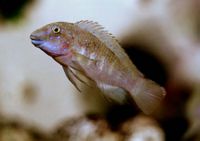Striped Goby Cichlid (Eretmodus cyanostictus)
From The Aquarium Wiki
Striped Goby Cichlid
Eretmodus cyanostictus
151 Litres (40 US G.)
6-8 cm (2.4-3.1")
Freshwater
8.0 - 9.0
24 -26 °C (75.2-78.8°F)
9-19 °d
1:1 M:F
5-8 years
Family
Cichlidae
This animal is available captive bred
Contents
Origin[edit]
- Originates from the 'surge zone' of lake Tanganyika, where the water is less than 3 feet deep and buffeted by strong waves. These fish eat algae from rocks in such biomes, using their non-functional swim bladders and unusual shape to avoid being swept away by the current.
Sexing[edit]
- An extremely monomorphic species, with males being only slightly larger than females and being physically identical. As fry, however, males are a much darker brown than females for the first few days.
Tank compatibility[edit]
- Their herbivorious nature means that these fish are best mixed with other herbivorious cichlids, such as tropheus. They are best kept in mated pairs unless the tank is very large, as conspecific aggression is extreme in this species: however, once mated, pairs stay together for life and argue little.
Diet[edit]
- Strictly herbivorious cichlid that should get large quantities of plant matter and little protein.
Feeding regime[edit]
- These fish can graze constantly in the wild, so several small feedings each day should be provided.
Environment specifics[edit]
- Needs a rocky, well-oxygenated tank to thrive, preferably with strong lighting to encourage algae growth on rocks. Sand should also be present, as these cichlids ingest sand regularly and seem to use it to help them digest the algae that comprises the bulk of their diet. Like most Tanganyikan cichlids, they do not appreciate nitrates in the water, and two 25% water changes a week should be considered mandatory.
Behaviour[edit]
- These fish do not maintain permanent territories, instead briefly claiming rock faces when they breed. When they breed, the fish swim alongside each other, with their heads close together. The female will shake as she lays her eggs and then quickly turns around to pick them up. The male then shakes as he fertilizes the eggs, right at the moment the female scoops them up.
- These fish, unlike most African cichlids, are bi-parental mouthbrooders: the female holds the eggs for 10-12 days, repeats the mating dance with the male, and then hands the males the fry to incubate for another 7-10 days. The male releases the fry in shallow water to reduce predation risks, and after this the parents largely ignore the fry. Fry will take crushed spirulina immediately, and are best removed from the tank to encourage the parents to breed again.
Identification[edit]
- Distinctive, compressed cichlid that - as the common names imply - looks a lot like a goby. Unfortunately, distinguishing it from the other goby cichlids is very difficult.
Pictures[edit]
External links[edit]
- Fishbase (Mirrors:
 )
)
